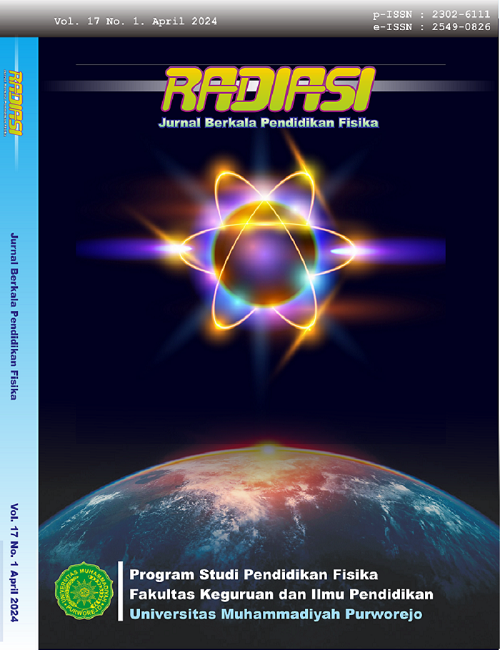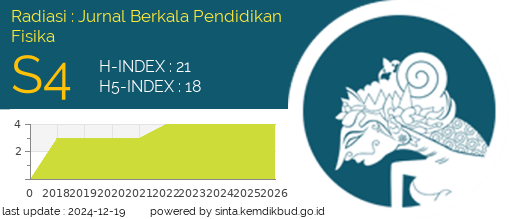Literature Study: Using Schoology LMS in Physics Learning at Schools in Indonesia
Abstract
Education in Indonesia has moved towards a broader digital approach. Information and communication technology development has encouraged many schools and educational institutions to look for new ways to integrate technology into teaching. One way is by utilizing a Learning Management System (LMS). One LMS platform that is quite widely used is Schoology. This research aims to find out how Schoology is used in physics learning in schools in Indonesia. The method used in this research is Systematic Literature Review (SLR), namely by finding, selecting, and synthesizing studies submitted for a specific question by following a systematic, transparent, and iterative process. Researchers chose 14 articles sourced from Google Scholar for analysis. These articles are grouped into certain groups to simplify the analysis process. This research found that the use of Schoology is quite good in facilitating physics learning in schools. However, Schoology should not be used in full, educators must play an active role so that students can still understand the material presented. Therefore, the learning method that is suitable for using Schoology in physics learning is the blended learning method.
Keyword: LMS, Schoology, Physics Learning, Indonesian School
Downloads
References
R. S. Miasari et al., “Teknologi Pendidikan Sebagai Jembatan Reformasi Pembelajaran Di Indonesia Lebih Maju,” J. Manaj. Pendidik. Al Hadi, vol. 2, no. 1, p. 53, 2022, doi: 10.31602/jmpd.v2i1.6390.
A. Fathurohman et al., “Effectiveness of Using the Mobile Learning App for STEM-Based High School Physics Materials as Indonesian Student Learning Resources on Learning Outcomes,” J. Penelit. Pendidik. IPA, vol. 9, no. 3, pp. 1018–1023, 2023, doi: 10.29303/jppipa.v9i3.2991.
M. E. Nurazri, L. Surya, and A. Fathurohman, “Analisis Motivasi Belajar Peserta Didik pada Materi Fisika Terhadap Pembelajaran Daring ( Online ) di SMA Sejahtera Palembang,” SINAPMASAGI (Seminar Nas. Pembelajaran Mat. Sains dan Teknol., vol. 1, pp. 30–39, 2021.
U. H. Salsabila, P. F. Fitrah, and A. Nursangadah, “Eksistensi Teknologi Pendidikan dalam Kemajuan Pendidikan Islam Abad 21,” J. Edusciense, vol. 7, no. 2, pp. 1–11, 2020.
I. Salamah, L. Lindawati, M. Fadhli, and R. Kusumanto, “Evaluasi Pengukuran Website Learning Management System Polsri Dengan Metode Webqual 4.0,” J. Digit, vol. 10, no. 1, p. 1, 2020, doi: 10.51920/jd.v10i1.151.
Widayanti, A. Abdurrahman, and A. Suyatna, “Future Physics Learning Materials Based on STEM Education: Analysis of Teachers and Students Perceptions,” J. Phys. Conf. Ser., vol. 1155, no. 1, 2019, doi: 10.1088/1742-6596/1155/1/012021.
Julius, “Implementasi Learning Management System (LMS) Berbantuan Edmodo Untuk Meningkatkan Hasil Belajar Siswa Pada Materi Fluida Dinamis Jurnal Berkala Pendidikan Fisika,” J. Berk. Pendidik. Fis., vol. 12, pp. 38–45, 2019.
F. Ferdianto and Dwiniasih, “Learning Management System (LMS) schoology: Why it’s important and what it looks like,” J. Phys. Conf. Ser., vol. 1360, no. 1, 2019, doi: 10.1088/1742-6596/1360/1/012034.
E. Supriasih, A. Fathurohman, and I. Sriyanti, “Flipped Classroom: Its Implementation and Impact in Science Learning (A Case Study During the Covid-19 Pandemic),” J. Pendidik. Fis., vol. 11, no. 1, pp. 103–114, 2023, doi: 10.26618/jpf.v11i1.8105.
I. H. Kusnadi, A. A. Hizraini, D. Aswita, H. Munandar, and A. Fathurohman, “The Analysis of Online Learning Devices Development Using The PjBL-Steam Model to Improve Student Environmental Literacy,” J. Educ., vol. 6, no. 1, pp. 2334–2338, 2023, doi: 10.31004/joe.v6i1.3250.
D. Badiro, S. Syuhendri, and A. Fathurohman, “Pengembangan Media Pembelajaran Aplikasi Android Berbasis Teori Perubahan Konseptual Materi Tata Surya Dan Fase Bulan Mata Kuliah Ipba,” J. Inov. dan Pembelajaran Fis., vol. 6, no. 1, pp. 103–112, 2019.
M. Azairok and A. Fathurohman, “Development of E-Learning Based Learning Media Assisted by Chamilo in Learning Physics to Improve Learning Outcomes of High School Students,” J. Penelit. Pendidik. IPA, vol. 9, no. 10, pp. 7871–7878, 2023, doi: 10.29303/jppipa.v9i10.4594.
M. Monalisa, A. S. Budi, and V. Serevina, “Learning Cycle 5E Menggunakan E-Learning Berbasis Schoology Pada Materi Elastisitas Dan Hukum Hooke,” Pros. Semin. Nas. Fis., vol. VIII, pp. SNF2019-PE-107–114, 2019, doi: 10.21009/03.snf2019.01.pe.14.
İ. N. GÜRSOY and D. ATİK KARA, “A Systematic Literature Review on Curriculum Studies Addressing Social Inequalities,” Kuramsal Eğitimbilim, vol. 16, no. 1, pp. 72–106, 2023, doi: 10.30831/akukeg.1141332.
M. R. N. Irsyad et al., “Tren Penelitian E-Learning pada Jurnal Terindeks SINTA di Indonesia,” Inf. Syst. Educ. Prof. J. Inf. Syst., vol. 7, no. 2, p. 117, 2023, doi: 10.51211/isbi.v7i2.2030.
T. Aminoto and H. Pathoni, “Penerapan Media E-Learning Berbasis Schoology Untuk Meningkatkan Aktivitas dan Hasil Belajar Materi Usaha dan Energi Di Kelas XI SMA N 10 Kota Jambi Tugiyo,” Suparyanto dan Rosad (2015, vol. 8, no. 1, pp. 13–29, 2014.
N. Hasanah, E. Suyanto, and W. Suana, “E-Learning dengan Schoology Sebagai Suplemen Pembelajaran Fisika Materi Elastisitas dan Hukum Hooke,” no. 1, pp. 71–81, 2016.
W. Wijayanti, N. Maharta, and W. Suana, “Pengembangan Perangkat Blended Learning Berbasis Learning Management System pada Materi Listrik Dinamis,” J. Ilm. Pendidik. Fis. Al-Biruni, vol. 6, no. 1, pp. 1–12, 2017, doi: 10.24042/jpifalbiruni.v6i1.581.
I. Alexandro, N. Maharta, and W. Suana, “Pengembangan Perangkat Blended Learning Berbasis Learning Management System (LMS) dengan Model Pembelajaran Inkuiri pada Materi Listrik Statis,” Pros. Semin. Nas. Pendidik. FKIP UNTIRTA, vol. 6, no. 1, pp. 1–12, 2017, doi: 10.24042/jpifalbiruni.v6i1.581.
M. Misbah, W. Aji Pratama, S. Hartini, and D. Dewantara, “Pengembangan E-Learning Berbasis Schoology pada Materi Impuls dan Momentum untuk Melatihkan Literasi Digital,” PSEJ (Pancasakti Sci. Educ. Journal), vol. 3, no. 2, pp. 109–114, 2018, doi: 10.24905/psej.v3i2.107.
W. S. Ambar Ningsih, W. Suana, and N. Maharta, “Pengaruh Penerapan Blended Learning Berbasis Schoology Terhadap Kemampuan Berpikir Kritis Siswa,” Konstan - J. Fis. Dan Pendidik. Fis., vol. 3, no. 2, pp. 85–93, 2018, doi: 10.20414/konstan.v3i2.16.
A. Anggraeni, E. Supriana, and A. Hidayat, “Pengaruh Blended Learning terhadap Kemampuan Berpikir Kritis Siswa SMA pada Materi Suhu dan Kalor,” J. Pendidik. Teor. Penelitian, dan Pengemb., vol. 4, no. 6, p. 758, 2019, doi: 10.17977/jptpp.v4i6.12505.
W. Suana, W. S. A. Ningsih, N. Maharta, and N. M. A. A. Putri, “The effect of blended learning setting on students’ critical thinking skills in physics,” J. Phys. Conf. Ser., vol. 1572, no. 1, 2020, doi: 10.1088/1742-6596/1572/1/012073.
S. Pratiwi, K. Wiyono, and Zulherman, “Pengembangan E-Learning Materi Hukum Newton Untuk Meningkatkan Keterampilan Berpikir Kritis Siswa Sekolah Menengah Atas,” JPF (JURNAL Pendidik. Fis. FKIP UM METRO, vol. 8, no. 2, pp. 172–185, 2020.
A. Widayoko, “Penggunaan LMS Schoology Pada Pembelajaran Fisika SMA Materi Fluida Statis Saat Pandemi Covid-19,” J. Ris. Pendidik. Fis., vol. 6, no. 1, pp. 13–19, 2021, [Online]. Available: http://journal2.um.ac.id/index.php/jrpf/.
H. Hartanto, L. Marlina, and K. Wiyono, “Pengembangan E-Schoology Materi Getaran dan Gelombang untuk Meningkatkan Keterampilan Berpikir Kritis Siswa Sekolah Menengah Pertama,” J. Ilm. Pendidik. Fis., vol. 5, no. 2, p. 211, 2021, doi: 10.20527/jipf.v5i2.3759.
A. Asrizal, U. Khairi, Yulkifli, M. Murtiani, and V. Mardian, “The Effect of Blended Learning Model (BLM) on Student Achievements: A Meta-Analysis,” J. Penelit. Pendidik. IPA, vol. 8, no. 5, pp. 2451–2459, 2022, doi: 10.29303/jppipa.v8i5.2260.
I. T. Monika, S. D. Fatmaryanti, and A. Maftukhin, “Pengembangan Media E-Learning dengan Schoology Berbasis Multirespresentasi Pada Peserta Didik,” J. Inov. Pendidik. Sains, vol. 3, no. 1, pp. 9–15, 2022.
T. T. T. Phan, C. T. Vu, P. T. T. Doan, D. H. Luong, and T. P. Bui, “Two decades of studies on learning management system in higher education: A bibliometric analysis with Scopus database 2000-2020,” J. Univ. Teach. Learn. Pract., vol. 19, no. 3, 2022, doi: 10.53761/1.19.3.09.
R. Yavich and N. Davidovitch, “The Effect of Assimilating Learning Management Systems on Parent Involvement in Education,” World J. Educ., vol. 11, no. 3, p. 60, 2021, doi: 10.5430/wje.v11n3p60.
N. Nazhifah and A. Fathurohman, “Teachers’ Perspectives on the Learning Management System (LMS) in Physics Subject: A Preliminary Study,” J. Ilm. Pendidik. Fis., vol. 7, no. 1, p. 31, 2023, doi: 10.20527/jipf.v7i1.7224.
W. A. Innocent and O. S. Masue, “Applicability of E-Learning in Higher Learning Institutions in Tanzania,” Int. J. Educ. Dev. Using Inf. Commun. Technol., vol. 16, no. 2, pp. 242–249, 2020.
B. Çiftçi, “The Effect of Blended Learning on Academic Achievement and Attitudes at Social Studies Courses,” Open J. Educ. Res., vol. 4, no. 2, pp. 143–150, 2020, doi: 10.32591/coas.ojer.0402.05143c.
M. M. Castro-Rodríguez, D. Marín-Suelves, S. López-Gómez, and J. Rodríguez-Rodríguez, “Mapping of scientific production on blended learning in higher education,” Educ. Sci., vol. 11, no. 9, 2021, doi: 10.3390/educsci11090494.
S. Hrastinski, “What Do We Mean by Blended Learning?,” TechTrends, vol. 63, no. 5, pp. 564–569, 2019, doi: 10.1007/s11528-019-00375-5.
Z. Mihret, M. Alemu, and S. Assefa, “Effectiveness of blended physics laboratory experimentation on pre-service physics teachers’ understanding of the nature of science,” Pedagog. Res., vol. 8, no. 1, p. em0144, 2022, doi: 10.29333/pr/12607.
Copyright (c) 2024 Apit Fathurohman, Allika Fitonia, Yuliana Yuliana

This work is licensed under a Creative Commons Attribution-NonCommercial 4.0 International License.




